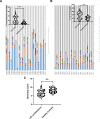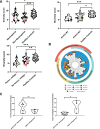Context-dependent T-cell Receptor Gene Repertoire Profiles in Proliferations of T Large Granular Lymphocytes
- PMID: 37469801
- PMCID: PMC10353713
- DOI: 10.1097/HS9.0000000000000929
Context-dependent T-cell Receptor Gene Repertoire Profiles in Proliferations of T Large Granular Lymphocytes
Abstract
T cell large granular lymphocyte (T-LGL) lymphoproliferations constitute a disease spectrum ranging from poly/oligo to monoclonal. Boundaries within this spectrum of proliferations are not well established. T-LGL lymphoproliferations co-occur with a wide variety of other diseases ranging from autoimmune disorders, solid tumors, hematological malignancies, post solid organ, and hematopoietic stem cell transplantation, and can therefore arise as a consequence of a wide variety of antigenic triggers. Persistence of a dominant malignant T-LGL clone is established through continuous STAT3 activation. Using next-generation sequencing, we profiled a cohort of 27 well-established patients with T-LGL lymphoproliferations, aiming to identify the subclonal architecture of the T-cell receptor beta (TRB) chain gene repertoire. Moreover, we searched for associations between TRB gene repertoire patterns and clinical manifestations, with the ultimate objective of discriminating between T-LGL lymphoproliferations developing in different clinical contexts and/or displaying distinct clinical presentation. Altogether, our data demonstrates that the TRB gene repertoire of patients with T-LGL lymphoproliferations is context-dependent, displaying distinct clonal architectures in different settings. Our results also highlight that there are monoclonal T-LGL cells with or without STAT3 mutations that cause symptoms such as neutropenia on one end of a spectrum and reactive oligoclonal T-LGL lymphoproliferations on the other. Longitudinal analysis revealed temporal clonal dynamics and showed that T-LGL cells might arise as an epiphenomenon when co-occurring with other malignancies, possibly reactive toward tumor antigens.
Copyright © 2023 the Author(s). Published by Wolters Kluwer Health, Inc. on behalf of the European Hematology Association.
Conflict of interest statement
The authors have no conflicts of interest to disclose.
Figures






Similar articles
-
Characteristics of T-cell large granular lymphocyte proliferations associated with neutropenia and inflammatory arthropathy.Arthritis Res Ther. 2008;10(3):R55. doi: 10.1186/ar2424. Epub 2008 May 12. Arthritis Res Ther. 2008. PMID: 18474096 Free PMC article.
-
T-large granular lymphocyte leukemia: current molecular concepts.Hematology. 2006 Aug;11(4):245-56. doi: 10.1080/10245330600774793. Hematology. 2006. PMID: 17178663 Review.
-
Clonal T-cell large granular lymphocyte proliferations in childhood and young adult immune dysregulation conditions.Pediatr Blood Cancer. 2020 May;67(5):e28231. doi: 10.1002/pbc.28231. Epub 2020 Mar 2. Pediatr Blood Cancer. 2020. PMID: 32124536
-
STAT3 mutations in "gray-zone" cases of T-cell large granular lymphocytic leukemia associated with autoimmune rheumatic diseases.Front Med (Lausanne). 2022 Aug 31;9:1000265. doi: 10.3389/fmed.2022.1000265. eCollection 2022. Front Med (Lausanne). 2022. PMID: 36117975 Free PMC article.
-
Clinical features of large granular lymphocyte leukemia.Semin Hematol. 2003 Jul;40(3):185-95. doi: 10.1016/s0037-1963(03)00133-1. Semin Hematol. 2003. PMID: 12876667 Review.
Cited by
-
T Cell Repertoire Analysis as a Molecular Signature of the Spectrum of T-LGL Lymphoproliferative Disorders: Tracing the Literature.Curr Issues Mol Biol. 2025 Apr 8;47(4):264. doi: 10.3390/cimb47040264. Curr Issues Mol Biol. 2025. PMID: 40699662 Free PMC article. Review.
References
-
- Lamy T, Moignet A, Loughran TP, Jr. LGL leukemia: from pathogenesis to treatment. . Blood. 2017;129:1082–1094. - PubMed
-
- Mohan SR, Maciejewski JP. Diagnosis and therapy of neutropenia in large granular lymphocyte leukemia. Curr Opin Hematol. 2009;16:27–34. - PubMed
-
- Langerak AW, Sandberg Y, van Dongen JJM. Spectrum of T-large granular lymphocyte lymphoproliferations: ranging from expanded activated effector T cells to T-cell leukaemia. Br J Haematol. 2003;123:561–562. - PubMed
-
- Bockorny B, Dasanu CA. Autoimmune manifestations in large granular lymphocyte leukemia. Clin Lymphoma Myeloma Leuk. 2012;12:400–405. - PubMed
LinkOut - more resources
Full Text Sources
Miscellaneous
